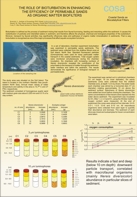

Macrofauna of the sandy beaches are often abundant and, in some cases, attain exceptionally high densities. Their main feature is the high degree of mobility displayed by all species. These animals may vary from a few mm to 20 cm in length. The macrofauna community consists of those organisms too large to move between the sand grains. The macrofauna of sandy beaches includes most major invertebrate taxa although it has been recognised that molluscs, crustaceans and polychaetes are the most important. There is a tendency for crustaceans to be more abundant on tropical sandy beaches or more exposed beaches and molluscs to be more abundant on less exposed and on temperate beaches although there are many exceptions of this and polychaetes are sometimes more abundant than either of this taxa. Generally crustaceans dominate the sands towards the upper tidal level, molluscs lower down (Brown & McLachlan 1990). Physical factors, primary wave action and particle size of the sand largely determine distribution and diversity of the invertebrate macrofauna of sandy beaches. Food input and surf-zone productivity may determinate the abundance population. Water movement is important parameter controlling macrofaunal distribution on beaches.




 The
role of bioturbation... (poster).
The
role of bioturbation... (poster).